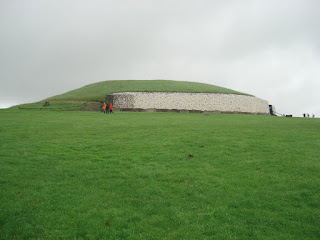One of the interesting aspects in moving from Seattle to Greensboro is the perspective on history which we have moved in to. While the history around Seattle is interesting, particularly that of the interaction between Native Americans and early settlers, from the perspective of North Carolina all that is modern history.
Now we live (when we are at home) only a mile from the site of one of the turning points in the Revolutionary War—our home is just off Old Battleground Way and near New Garden Road, a strip of asphalt that covers the marching line of the British soldiers as they headed north to encounter the Continental Army. Downtown Greensboro has a plaque noting where the government of the Confederacy met on several occasions, and the Woolworth on Elm Street (Main Street) is the site of the first sit-in during the Civil Rights movement. The roots in the south are deep.

But after a little time in Ireland, this history migrates into the folder entitled Recent Events. As I have noted before, we have visited burial sites dating back between four and five thousand years, walked past St. Patrick’s well, visited the landing place of the Vikings, and strolled in the central courtyard of an English castle built in the twelfth century. Around the corner from us is the Bleeding Horse Pub which bears a plaque honoring its foundation in 1649, just up the street is a public library founded in 1701 (Marsh’s Library, containing some of Jonathan Swift’s collection), and a church that is only 500 years old is not worth a footnote in the historical record of the area. The roots here are much deeper.
But being surrounded by the past does not mean being limited to the past, and the fascination of this place in this time is at least to a large part in the dynamics of today. Entry into the EU changed the face of Ireland, and moved it from the sideline to the center. The infrastructure was developed, high-tech and low-tech industries grew and prices skyrocketed. People from all over the world have flocked to Ireland, many of them students or professional people, in fact so many that a recent mapping of Dublin was striking in the amount of red—red meaning over half of the current residents were not born in Ireland. All of this is behind the description of Ireland as the Celtic Tiger.

Yet even this more recent history is giving way to news that this part of the world continues to change. Three signs of this have appeared in the headlines recently. One is the dramatic change in the public behavior of Dr. Ian Paisley, the most vocal proponent of maintaining the union of Northern Ireland and Great Britain, and Gerry Adams, the leader of Sinn Fein, the party most committed to a united Ireland. In the past month they have sat together, laughed together and worked together as they both bear positions of leadership in a newly constituted Northern Ireland Assembly.

People in the north and south are amazed at this turn of events, and believers attribute it to a work of God in answer to prayers for peace on the island.
The second is an announcement last week that Aer Lingus, a global symbol and national pride of the Republic of Ireland, is going to abandon its Shannon, Ireland, routes and open new ones in Belfast, Northern Ireland. The people and politicians of Ireland are incensed at this move, the Irish clergy have issued a letter decrying the prioritization of profits over people, but it is a sign of the changing times.
Finally, Nancy and I spent an hour one recent afternoon greeting a Viking ship, the Sea Stallion, as it sailed and rowed into Dublin Harbor. This ship was built in the Viking Ship Museum in Denmark and built to show how Viking vessels would have appeared over a thousand years ago. The interest in this ship stemmed from the 1962 discovery in Denmark of five Viking ships, with the subsequent determination that one of them had been constructed in the Dublin area. This discovery spurred an interest in Viking sailing by historians, the ship was built using ancient techniques, and the crew of 60 sailed it from Denmark to Dublin. As a social experiment (60 people in an open boat with no privacy) the project was of interest to many, but as an historical statement it was to others. The dock this afternoon was lined with thousands of people, dignitaries from several countries, television and other media—all there to greet a ship reminiscent of ones that 1,211 years ago arrived at the same site to raid, pillage and rob…

What do I make of all this? Well, one thing is that the gospel faces an accelerating challenge—speaking to people in a world that is rapidly changing. The second thing is that the gospel is relevant to the world at every stage, every step, and every point in history. The message of the love of God showed so clearly to humanity in the person and work of Jesus Christ is a timeless message. It has had a formative shaping power in the history of Ireland—and it can today. The gospel is not stamped with a time-date:
Best if Used By …. It is time-less… And it is the believer’s job to show that to the world. So the author of Hebrews reminds us,
Jesus Christ is the same yesterday and today and forever.Emily, Steve and Colette arrive in a few days. Then two more weeks and our time in Dublin will be over. It has been good.













